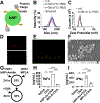Modeling the kinetics of lymph node retention and exposure of a cargo protein delivered by biotin-functionalized nanoparticles
- PMID: 37652212
- PMCID: PMC10592217
- DOI: 10.1016/j.actbio.2023.08.048
Modeling the kinetics of lymph node retention and exposure of a cargo protein delivered by biotin-functionalized nanoparticles
Abstract
Generation of protective immunity through vaccination arises from the adaptive immune response developed primarily in the lymph nodes drained from the immunization site. Relative to the intramuscular route, subcutaneous administration allows for direct and rapid access to the lymphatics, but accumulation of soluble protein antigens within the lymph nodes is limited. Subunit vaccines also require immune stimulating adjuvants which may not accumulate in the same lymph nodes simultaneously with antigen. Herein we report the use of biotinylated poly (lactic-co-glycolic acid) nanoparticles (bNPs) to enhance delivery of a model protein antigen to the lymphatics. bNPs provide dual functionality as adjuvant and vehicle to localize antigens with stimulated immune cells in the same draining lymph node. Using streptavidin as a model antigen, which can be loaded directly onto the bNP surface, we evaluated the kinetics of lymph node occupancy and adaptive immune responses in wildtype C57BL/6 mice. Antigen exposure in vivo was significantly improved through surface loading onto bNPs, and we developed a working kinetic model to account for the retention of both particles and antigen in draining lymph nodes. We observed enhanced T cell responses and antigen-specific B cell response in vivo when antigen was delivered on the particle surface. This work highlights the advantage of combining intrinsic adjuvant and antigen loading in a single entity, and the utility of kinetic modeling in the understanding of particle-based vaccines. STATEMENT OF SIGNIFICANCE: Development of safe and effective subunit vaccines depends on effective formulations that render optimized exposure and colocalization of antigens and adjuvants. In this work, we utilize a nanoparticle system which features self-adjuvanting properties and allows for surface loading of recombinant protein antigens. Using in vivo imaging, we demonstrated prolonged co-localization of the antigen and adjuvant particles in draining lymph nodes and provided evidence of B cell activation for up to 21 days following subcutaneous injection. A pharmacokinetic model was developed as a step towards bridging the translational gap between particulate-based vaccines and observed outcomes. The results have implications for the rational design of particle-based vaccines.
Keywords: Lymphatics, adjuvant; Modeling; Nanoparticles; PLGA, pharmacokinetics; Subcutaneous depot; Subunit vaccine.
Copyright © 2023 Acta Materialia Inc. Published by Elsevier Ltd. All rights reserved.
Conflict of interest statement
Declaration of Competing Interests Authors declare that they have no competing interests.
Figures






Similar articles
-
Immune Cells Activating Biotin-Decorated PLGA Protein Carrier.Mol Pharm. 2022 Jul 4;19(7):2638-2650. doi: 10.1021/acs.molpharmaceut.2c00343. Epub 2022 May 27. Mol Pharm. 2022. PMID: 35621214 Free PMC article.
-
Rational Design of PLGA Nanoparticle Vaccine Delivery Systems To Improve Immune Responses.Mol Pharm. 2019 Dec 2;16(12):5000-5012. doi: 10.1021/acs.molpharmaceut.9b00860. Epub 2019 Oct 25. Mol Pharm. 2019. PMID: 31621331
-
The Immunoenhancement Effects of Polyethylenimine-Modified Chinese Yam Polysaccharide-Encapsulated PLGA Nanoparticles as an Adjuvant.Int J Nanomedicine. 2020 Aug 5;15:5527-5543. doi: 10.2147/IJN.S252515. eCollection 2020. Int J Nanomedicine. 2020. PMID: 32848386 Free PMC article.
-
Lymphatic distribution considerations for subunit vaccine design and development.Vaccine. 2024 Apr 11;42(10):2519-2529. doi: 10.1016/j.vaccine.2024.03.033. Epub 2024 Mar 16. Vaccine. 2024. PMID: 38494411 Review.
-
Impact of nanoparticle properties on immune cell interactions in the lymph node.Acta Biomater. 2025 Jan 24;193:65-82. doi: 10.1016/j.actbio.2024.12.039. Epub 2024 Dec 17. Acta Biomater. 2025. PMID: 39701340 Review.
References
Publication types
MeSH terms
Substances
Grants and funding
LinkOut - more resources
Full Text Sources
Research Materials
Miscellaneous

